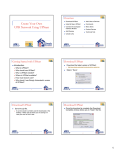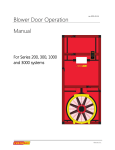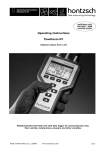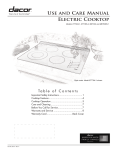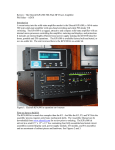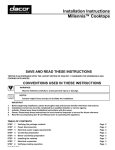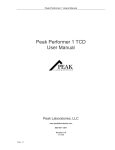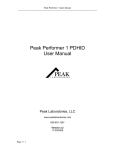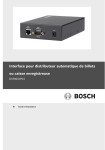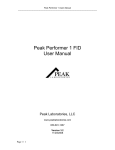Download UPStart Quickstart Guide:
Transcript
UPStart Quickstart Guide: How to Create Your Own UPB Network Table of Contents Download UPStart....................................................................................................................................... 4 Connecting the Computer Interface Module...................................................................................... 5 Getting Started with UPStart.................................................................................................................... 7 The UPStart Wizard..................................................................................................................................... 7 Select: Begin the UPStart Wizard ...................................................................................................... 7 Beyond the Wizard....................................................................................................................................18 Add Devices ........................................................................................................................................18 Changing and adding Links.....................................................................................................................21 Link Editing..................................................................................................................................................22 Visual Link Editor ..................................................................................................................................23 Dialog Link Editor..................................................................................................................................26 Edit Device Window .............................................................................................................................27 Saving a UPB Configuration File............................................................................................................29 Commands ..................................................................................................................................................30 Activate ................................................................................................................................................30 Deactivate............................................................................................................................................30 Goto On ...............................................................................................................................................30 Goto Off...............................................................................................................................................30 Snap On ...............................................................................................................................................30 Snap Off...............................................................................................................................................30 Quick On .............................................................................................................................................30 Quick Off .............................................................................................................................................30 Slow On................................................................................................................................................30 Slow Off ...............................................................................................................................................30 Fade Up................................................................................................................................................30 Fade Down ..........................................................................................................................................30 Null or Status .....................................................................................................................................30 No Command.....................................................................................................................................30 Panic......................................................................................................................................................30 Button/Rocker Modes..............................................................................................................................30 Menu Items .................................................................................................................................................31 Device (or Right Click on Device Icon)...........................................................................................31 Verify ....................................................................................................................................................31 Install/Replace....................................................................................................................................32 Copy Configuration ..........................................................................................................................32 Add Multiple.......................................................................................................................................32 Tools .........................................................................................................................................................33 Options.................................................................................................................................................33 2 Simply Automated Incorporated 5825 Avenida Encinas, Suite 101, Carlsbad, CA 92008 P 760.431.0000 F 760.431.2101 452-0000-0000 Rev. A Log Viewer ..........................................................................................................................................33 Network Communications Test.....................................................................................................35 KPE-06 Device Details ..............................................................................................................................36 Appliance Module, model: UMA-20-W .....................................................................................36 Lamp Module, model: UML-20-W...............................................................................................37 US2-40..................................................................................................................................................37 Factory Reset......................................................................................................................................38 Other Simply Automated UPB Lighting Devices ..........................................................................38 US11-30................................................................................................................................................38 USR........................................................................................................................................................38 Troubleshooting and Technical Talk....................................................................................................39 Adapting the US2-40 to demonstrate UPB and UPStart without wiring it into the wall ......42 3 Simply Automated Incorporated 5825 Avenida Encinas, Suite 101, Carlsbad, CA 92008 P 760.431.0000 F 760.431.2101 452-0000-0000 Rev. A The following are step by step instructions for using the UPStart software. Download UPStart 1. Download the latest version of UPStart: Open your Internet browser program and enter http://www.simply-automated.com/products/sa_upstart.htm into the Internet address field. The following window will open if you are using Windows XP and Internet Explorer. If you are using an older version of Windows you will need to have Win Zip or a similar program on your computer. A Win Zip download is available: http://www.download.com/3000-2250-10003164.html . 2. Select, “Save”. 3. A window opens that allows you to select where to save the zip file. It can be saved to a folder used for downloads or the desktop. Make note of where you are saving it in case you want to find it later. 4. Once the download is complete the Download Complete window allows you to “Open” the file. 5. A Windows Explorer window opens listing a single file. Double click on the executable file: UPB44Setup.exe. The 44 indicates the current version of UPStart as of this writing and is subject to change as UPStart evolves. As long as you have a program that opens “Zip” files on your computer the following window will appear: 4 Simply Automated Incorporated 5825 Avenida Encinas, Suite 101, Carlsbad, CA 92008 P 760.431.0000 F 760.431.2101 452-0000-0000 Rev. A 6. Click on Run to start the UPStart installation. 7. Select the defaults that appear in the installation screens. Advanced users can put the files where they would like them. The defaults install the UPStart program under Program Files in a folder named UPB. 8. Once the installation is completed click on Finished. Close the zip file window. UPStart has been installed in the Program Files folder. Connecting the Computer Interface Module 1. If you have not connected the Computer Interface Module (CIM), Model: UMC-DB9W, to your computer, do it now. a. Plug the CIM into a receptacle near your computer. b. Using the serial cable that came with the CIM plug the appropriate end into the CIM and the other into the serial port on your computer. Skip to c. if you have a serial port on your computer. If you do not have a serial port you can use a USB to serial adapter. i. The following is a list of USB to serial adapters that have been tested with the CIM and UPStart ELK ELKUSB232 – Sold by Home Controls SIIG JU-CB1S12 IO Gear USB-2930 IO GEAR GUC232A Belkin F5U109-CU Cables Unlimited USB-2920 BAFO Technologies BF-810 PCMCIA Card - Quatech SSP-100 Keyspan USA-19HS ii. Follow the installation directions that came with your USB adapter. iii. Even though you are using your USB port on your computer you must select the non USB Powerline Interface module in UPStart. To do that 5 Simply Automated Incorporated 5825 Avenida Encinas, Suite 101, Carlsbad, CA 92008 P 760.431.0000 F 760.431.2101 452-0000-0000 Rev. A you need to know the com port that your USB to serial adapter captured. 1. Go to Start → Control Panel → System → Hardware → Device Manager → Ports 2. Click on the “+” sign to drop down the ports connected to your computer. 3. Your USB adapter should be listed here with the com port it has been assigned by Windows. Make note of the com port. c. Connect the CIM to the USB adapter only after the USB port has been recognized by Windows. d. Open UPStart – See next section. 6 Simply Automated Incorporated 5825 Avenida Encinas, Suite 101, Carlsbad, CA 92008 P 760.431.0000 F 760.431.2101 452-0000-0000 Rev. A Getting Started with UPStart There are two sections to this discussion. The first section includes instructions for creating a new network. It introduces the UPStart Wizard, a step by step method of creating a new UPB network. The third section is for advanced users; who will learn how to create a UPB network without using the Wizard. The UPStart Wizard This introductory Wizard provides a step by step method of creating a UPB network with installed devices. In a nutshell the steps are: Add Devices, Create Links, Add Links to Devices and Save the File. Once devices and the Computer Interface Module are installed, Open UPStart. Select: Begin the UPStart Wizard Click Go – the Introduction window appears. 7 Simply Automated Incorporated 5825 Avenida Encinas, Suite 101, Carlsbad, CA 92008 P 760.431.0000 F 760.431.2101 452-0000-0000 Rev. A 1. Read the introduction… It is a good idea to read all the verbiage on the presented windows in this wizard. Reading and understanding will help working the UPStart beyond the Wizard. Click Next only after reading and understanding the explanation offered. 8 Simply Automated Incorporated 5825 Avenida Encinas, Suite 101, Carlsbad, CA 92008 P 760.431.0000 F 760.431.2101 452-0000-0000 Rev. A 2. The first step is to create a network. a. Enter the desired Network Name (16 characters). Typically it will be the address of an installation. b. Click on “Create Network” button. i. Upstart assigns a Network ID and Password. The Network ID will be briefly shown. The Password is randomly set. Both can be changed later. c. Click Next to continue. 9 Simply Automated Incorporated 5825 Avenida Encinas, Suite 101, Carlsbad, CA 92008 P 760.431.0000 F 760.431.2101 452-0000-0000 Rev. A 3. Adding devices is the next step. a. Read the screen, it really is good, essential information. b. Select the first device to add. i. Enter Room Name (16 characters). ii. Enter Device Name (16 characters). iii. Put device in set up mode. 1. For all plug-in and wired-in devices press the recessed button with a non-conductive tool such as a toothpick or a golf tee (also known as a UPB device configuration tool) 5 times consecutively. The LED should begin to flash green. 2. On the US11-30 or US2-40 wall switches press any button or rocker 5 times consecutively. The LED should begin to flash green. 3. Devices will stay in Setup mode for 5 minutes or until the button or rocker is pressed 2 times consecutively. 4. Time between button pushes must be less than ¾ of a second. c. This wizard allows installation of 12 devices. Continue until the desired devices or 12, which ever comes first, are added. d. Click Next. 10 Simply Automated Incorporated 5825 Avenida Encinas, Suite 101, Carlsbad, CA 92008 P 760.431.0000 F 760.431.2101 452-0000-0000 Rev. A 4. Create Links. a. Read introduction to Links, this is very essential to understand. A Link is synonymous to Scene. A Link can control one or many devices. b. Enter Link names (16 characters, again). Typically the names describe the function of the Link. They can also describe control of a device such as a Lamp Module (UML), Appliance Module (UMA) that is often only controlled by a Link or a Direct command from a control system. c. Click Next when all Link names are added. 11 Simply Automated Incorporated 5825 Avenida Encinas, Suite 101, Carlsbad, CA 92008 P 760.431.0000 F 760.431.2101 452-0000-0000 Rev. A 5. Add Links to Devices. a. Transmit Links. i. Click on the button on the screen that represents a button or rocker on the installed faceplate. ii. Select a Link from the drop down list. iii. Click Next and continue. 12 Simply Automated Incorporated 5825 Avenida Encinas, Suite 101, Carlsbad, CA 92008 P 760.431.0000 F 760.431.2101 452-0000-0000 Rev. A b. Receive Links i. Select devices that respond to the selected Link. ii. Set Level and Rate where appropriate. iii. Click Next to continue. 13 Simply Automated Incorporated 5825 Avenida Encinas, Suite 101, Carlsbad, CA 92008 P 760.431.0000 F 760.431.2101 452-0000-0000 Rev. A The UPStart Wizard has now added up to 12 devices, created up to 12 Links and is now ready to program the devices with the Links. 6. Click on “Program Network”. 14 Simply Automated Incorporated 5825 Avenida Encinas, Suite 101, Carlsbad, CA 92008 P 760.431.0000 F 760.431.2101 452-0000-0000 Rev. A 7. The following window appears, titled: “Multi-Device Operation”. All the devices that have been added first appear as a Yellow box. The box turns Pink when being programmed, which takes nearly 30 seconds per device. A Blue box represents a successfully programmed device. A Red box indicates a device that was not successfully programmed. There may be a problem communicating with that device at this point. Once the UPStart Wizard is complete, right-click on the device icon and select: Program. If that is not successful further troubleshooting may be required. Refer to Troubleshooting and Technical Talk in the “Create your own UPB Network” guide. 8. The Multi-Device Operation window will disappear when programming is complete. The “Program” window is present and >Next is no longer grayed out. 9. Click Next. 15 Simply Automated Incorporated 5825 Avenida Encinas, Suite 101, Carlsbad, CA 92008 P 760.431.0000 F 760.431.2101 452-0000-0000 Rev. A 10. Test Links. a. Click Activate to turn a Link on and Deactivate to turn a Link off. If it is not working as envisioned changes can be made by clicking Back or finishing the Wizard and performing edits by other methods available in UPStart. 16 Simply Automated Incorporated 5825 Avenida Encinas, Suite 101, Carlsbad, CA 92008 P 760.431.0000 F 760.431.2101 452-0000-0000 Rev. A 11. DONE! a. Click “Finish”. 12. Save UPB file. a. Save as address or home owners or other unique name. i. Default directory is c:/Program Files/UPB/Designs. To add more devices see the Add Devices section (page 18). To add or change Links see the Changing and Adding Links section (page 21). To edit a device double click on the device icon to open the Edit Device window. See the “Getting Started with Upstart” guide for more details. 17 Simply Automated Incorporated 5825 Avenida Encinas, Suite 101, Carlsbad, CA 92008 P 760.431.0000 F 760.431.2101 452-0000-0000 Rev. A Beyond the Wizard The next method is a step by step guide to creating a UPB network from installed devices without the help of the UPStart Wizard. This section is for Advanced Users or those who wish to become Advanced Users. 1. Open UPStart. a. In Windows XP click on Start → All Programs → UPB → UPStart. 2. The opening window will offer the following selections. a. Begin the UPStart Wizard. b. Open an existing network file. c. Create a new network file starting with choosing a network ID and password. d. Create a new network file that matches an already installed network. e. Use UPStart on my own. 3. The best selection to add newly installed devices is: b. Create a new network file starting with choosing a network ID and password. a. UPStart creates a UPB network file. As the devices are added the information is stored in the devices and in the UPStart file. 4. Once selected the following screen appears. 5. Enter the desired Network Name (16 Characters), Network ID (1 to 250) and Network Password (4 characters from 0-9 and A-F), then click “OK”. Add Devices or go to Device l Add… 1. Click on the Add Device Icon a. The Add Devices Wizard will open. 18 Simply Automated Incorporated 5825 Avenida Encinas, Suite 101, Carlsbad, CA 92008 P 760.431.0000 F 760.431.2101 452-0000-0000 Rev. A 2. To put a device into set up mode: a. For all plug-in devices press the recessed button with a non-conductive tool such as a toothpick or a golf tee (also known as a UPB device configuration tool) 5 times consecutively. The LED should begin to flash green. b. On the US11-30 or US2-40 wall switches press any button or rocker 5 times consecutively. The LED should begin to flash green. c. Devices will stay in Setup mode for 5 minutes or until the button or rocker is pressed 2 times consecutively. 3. Once the LED is flashing click on “>Next”. UPStart will read the device. 4. Click on “OK” when this is complete. a. If device is unable to be read it is likely that the device is on the “other” phase with respect to the UMC-DB9-W (CIM) location. It may be moved to another location on the same phase as the CIM (possibly the same circuit breaker), installed on a power strip plugged in to the same receptacle as the CIM or into the “always on” receptacle of the CIM. You may need a Phase 19 Simply Automated Incorporated 5825 Avenida Encinas, Suite 101, Carlsbad, CA 92008 P 760.431.0000 F 760.431.2101 452-0000-0000 Rev. A Coupler (Model ZPC-B or ZPC-W) to allow communication between the two phases of 120 Vac that is standard in most residential buildings. 5. Once the device is read and before it is added to the UPB Network it needs a Room Name, Device Name, Unit ID and the Device Type. a. Room Name is self explanatory (16 characters). b. Device Name is often the location in the room or the device being controlled (16 characters). c. Unit IDs are assigned sequentially. i. Some installers may have a plan for numbering rooms and can set the Unit ID to any number desired from 1-250. d. The Device Type – The Next button will be enabled after making a selection. i. Switches – This is the faceplate, single rocker, dual half height, etc. ii. Wired-in devices – Can be controlled by USR (Dedicated Remote Switch) and have Transmit capability when so connected. iii. Plug-In devices – No selection. e. Erase existing configuration – will erase all factory added Links (**This is not recommended for the US2-40**… see detail US2-40 page 40). 6. After clicking on “>Next” UPStart writes and verifies the entries. Click OK when complete. a. If unable to complete this step it may be necessary to put device into Factory Reset mode and start again. i. Factory Reset is accomplished by “tapping” (pressing until audible/tactile click is heard/felt and releasing) the button or rocker 10 times from set up mode. The LED will change color but continue blinking. One or two taps will put the device into run mode. Put the device back into set up mode to re-attempt adding the device (another 5 tap from run mode). 20 Simply Automated Incorporated 5825 Avenida Encinas, Suite 101, Carlsbad, CA 92008 P 760.431.0000 F 760.431.2101 452-0000-0000 Rev. A ii. 7. The following window will appear. If all devices are added select “Done”, if not “Add more devices”. 8. Continue until all installed devices are added to the UPStart file. Changing and adding Links To view the Links that have been created in your devices: 1. Click on Network → Link Names… a. The buttons correspond to the buttons on the table top controller and the US2-40. Link 241 is an internal Link that is used for Local Load control for the US2-40. Detail discussion is in section PEP Kit Device Details - US2-40 page 37. Default Links loaded into UPB devices allow production testing they may be removed, edited or used as they are. b. Clicking on any Link name in the top section of the window will reveal the devices that have the Link installed in the bottom window. i. Blue triangles (arrows pointing right) indicate transmitting devices ii. Purple triangles indicate receiving devices. iii. Orange footballs are LED indicators on transmitters, they are receiving devices. 21 Simply Automated Incorporated 5825 Avenida Encinas, Suite 101, Carlsbad, CA 92008 P 760.431.0000 F 760.431.2101 452-0000-0000 Rev. A 2. Links may be added from this screen by clicking on “New”. a. UPStart will default to the next available Link ID, #9 in this case. b. Links may be tested by Activating or Deactivating. c. Rename – allows the text “Name” to be edited. d. Remove unused – any Link that has “No” in the “In Use” column may be removed from the list. e. Edit Link – Opens the Dialog Link Editor. f. Delete Link – Removes and reprograms devices. 3. The same table may be opened from the Receive Component and Transmit Component tabs of the Edit Device window for any device. Link Editing There are several ways to edit the Links: 1. Visual Link Editor. 2. Dialog Link Editor. 3. Edit Device Window. 22 Simply Automated Incorporated 5825 Avenida Encinas, Suite 101, Carlsbad, CA 92008 P 760.431.0000 F 760.431.2101 452-0000-0000 Rev. A Visual Link Editor The Visual Link Editor is enabled by going to Tools → Options → and clicking on the check box at the bottom of the UPStart Operation tab. 1. Open the Visual Link Editor. Double click or right-click and select Edit a. Double click on the Link name in the folder Design Pane (left pane). b. The Display Pane (right pane) changes to the Visual Link Editor. 23 Simply Automated Incorporated 5825 Avenida Encinas, Suite 101, Carlsbad, CA 92008 P 760.431.0000 F 760.431.2101 452-0000-0000 Rev. A Visual Link Editor 2. Adding a device to the Link is a matter of clicking on the device in the Design Pane (left side) and drag and drop on the Display Pane (right side). a. A dialog box pops up. b. If the device is transmitting the Link click on the Rocker or Button radio button in the Transmit Components area. 1. Select available position on device. 2. Click on the Component Setup button (Link Activator). 3. A window appears with the descriptions of the modes. 24 Simply Automated Incorporated 5825 Avenida Encinas, Suite 101, Carlsbad, CA 92008 P 760.431.0000 F 760.431.2101 452-0000-0000 Rev. A 4. Select the desired Mode. Click OK. c. If the device is receiving the Link click on the Receive Components radio button, select the desired dim Level and the Fade Rate. 3. Continue adding devices and setting their response until all desired devices are added to the Link. 4. Right click in the open gray space in the Display screen, a dialog box pops up. Click on Program to program the added devices. 5. Click OK when programming complete. 25 Simply Automated Incorporated 5825 Avenida Encinas, Suite 101, Carlsbad, CA 92008 P 760.431.0000 F 760.431.2101 452-0000-0000 Rev. A Dialog Link Editor 1. Click on Network → Link Names… 2. Click on the desired Link in the top window of the Links screen. 3. Click Edit Link X (where X is the Link ID of the selected Link). 4. Controllers are transmitting devices, Presets and Indicators are receiving devices. 5. Add Controller: a. Click on Add Controller button. b. Select the desired device from the selection window by clicking on the device name and button position then click OK. This device will have the Link added to its Transmit Component table when programming is completed. c. Click on the button with the Mode name (Link Activator for instance in the screen shot above the Mode names are: Custom Button, Top Super Rocker and Bottom Super Rocker). d. A window appears with the descriptions of the modes. Select the desired mode. It can be changed later. 6. Add Preset a. Presets are devices that have the Link in their Receive Component table. b. Click on Add Preset c. Select the Level and Fade Rate. Test is optional. 26 Simply Automated Incorporated 5825 Avenida Encinas, Suite 101, Carlsbad, CA 92008 P 760.431.0000 F 760.431.2101 452-0000-0000 Rev. A 7. Indicators. a. Buttons that have LEDs are referred to as indicators. They are Receiving Components also. A device with LED indicators should have the LED responding to the same Link. b. If you have buttons that interact, the Groups and function (Turn Off) can be set so the LED follows the function. LEDs for other buttons can turn on or off or do nothing when a button is pressed. An example: There is a room of lights that are set for 3 dimming levels. A separate Link is set for each desired dimming level. A separate button is assigned to each Link, 1, 2 & 3. If all buttons are in the same group and set to Turn Off then when any of the three buttons are pressed the LED on that button will illuminate and the button that was previously illuminated will extinguish. 8. Click on “Program All needed to establish this Link” to program the Link into each selected device. 9. Click on OK. Edit Device Window Double clicking on any device icon opens the Device Edit screen for that device. The Links and settings for the PEP Kit are now viewable. The device depicted is the US2-40 mounted with a quad rocker faceplate. 27 Simply Automated Incorporated 5825 Avenida Encinas, Suite 101, Carlsbad, CA 92008 P 760.431.0000 F 760.431.2101 452-0000-0000 Rev. A The tabs are: ID, Receive Components, Transmit Components, Options, Advanced, Test and Communications Test. 1. Click on Transmit Component tab. 2. The Links installed into the PEP Kit may be changed to provide the functionality desired. a. If you are changing the faceplate make that change in the lower right corner of this window – Device Type. 1. Changing the Device Type will change all the settings. b. Click on the pull down for the selected rocker or button. Select the desired Link. c. Select the desired Mode. d. Click on “OK” and “Yes. Go ahead”, to program the changes if there are no other desired changes. Program Device may also be used, the Edit Device window will remain open. 3. Click on the Receive Components tab. a. Click on any position that is labeled, “Unused”. b. Select the desired Link. c. Set the desired Level. d. Set the desired Fade Rate. 4. Options and Advanced features vary by device. Generally the Options tab allows: a. The color of the LED to be changed. 28 Simply Automated Incorporated 5825 Avenida Encinas, Suite 101, Carlsbad, CA 92008 P 760.431.0000 F 760.431.2101 452-0000-0000 Rev. A b. c. d. e. 5. 6. 7. 8. A status message sent when the rocker or button is pressed. Setting the default fade rate. Enabling/Disabling the dimming (disable for fluorescent lighting). Adjust features unique to the selected device. 1. Lamp Module – Lamp switch trigger. a) Allows manual control of lamp from lamp switch. 2. US2-40 – Transmit enables, local load control should not transmit. Test – allows control of local load from UPStart. Communications Test – UPB communications are tested between device and Computer Interface Module (CIM… sometimes called a PIM for Powerline Interface Module. ID tab – Enables view of Network ID, Password, Firmware Version and other fascinating information. Allows editing of Network Name, Room Name, Device Name and Device ID. When all changes are complete click on Program Device or OK followed by Yes. Go ahead. Saving a UPB Configuration File As with any software programs you may want to save your configuration file occasionally as you continue working. Save the file by clicking on the disk icon or selecting: File... Save or Save As… Once the configuration is complete and all edits have been completed remember to do a final “Save” to ensure all updates are included. If you lose the file it can be recreated from the installed devices. (File… New file from network…). We recommend keeping a copy with the house and on the computer used for installations or a company resource. Creating a new file from the installed network can take 2 or more minutes per device. 29 Simply Automated Incorporated 5825 Avenida Encinas, Suite 101, Carlsbad, CA 92008 P 760.431.0000 F 760.431.2101 452-0000-0000 Rev. A Commands UPB Commands are sent when a device has been configured to transmit a Link. There are commands that are fixed to each defined Mode. The Custom Button or Custom Rocker Modes allow the user to select the commands that are sent when a rocker or button is pressed. Activate – The response to the Activate command is dictated by the Receive Component table of the device(s) receiving the Link. The light Level and Fade Rate may be unique to each device. Light Level can be set from 100% down to 0%. 0% would appear to be off; however, if you Fade Up a Link even the devices set for 0% will brighten. Devices can be turned off by setting the light Level to 0%. A good rule of thumb would be to not allow Fade UP from a Link that has devices that are set to 0%. The best option is to create another Link that sets the next desired light Level. Deactivate – The response to the Deactivate command is to turn off. Goto On – Level goes to 100% at the default Fade Rate. Goto Off – Level goes to 0% at the default Fade Rate. Snap On – Level goes to 100% with zero Fade Rate. Snap Off – Level goes to 0% with zero Fade Rate. Quick On – Level goes to 100% at 0.8 seconds. Quick Off – Level goes to 0% at 0.8 seconds. Slow On – Level goes to 100% in 30 seconds. Slow Off – Level goes to 0% in 30 seconds. Fade Up – Level increases to 100% in 6.6 seconds or until Fade Stop. Fade Down – Level decreases to 0% in 6.6 seconds or until Fade Stop. Null or Status – Transmits UPB command that does nothing. No Command – No UPB command sent. Panic – Blinks the load or Linked module. Button/Rocker Modes The Mode describes the function of the button or rocker. Each defined Mode includes a setting for Single-Tap, Double-Tap, Hold and Release. A UPB command can be transmitted with each of the above actions. For instance, Top Super Rocker is defined as: Single-Tap Activate Double-Tap Snap On Hold Fade Up Release Fade Stop Top Super Rocker and Bottom Super rocker are recommended for load control rockers. Link Activator and Link Deactivator are recommended for rockers that are controlling Links. It is not recommended to “fade” or “dim” a Link. The multi-button faceplates have their own Mode, Super Multi-Button and Multi-Button. Super Multi-Button is recommended for load control buttons, Multi-Button for buttons 30 Simply Automated Incorporated 5825 Avenida Encinas, Suite 101, Carlsbad, CA 92008 P 760.431.0000 F 760.431.2101 452-0000-0000 Rev. A that are controlling Links. It is not recommended to “fade” or “dim” a Link. Why? A Link might include devices that are set to 0%. If that Link is Faded Up even the devices that are off (0%) will Fade Up. There is a Custom Button and Custom Rocker available to provide a desired function not included in the Mode selection. Modes can be added if they are frequently used. Menu Items Device (or Right Click on Device Icon) Verify – Confirms that the programming in the device and in the UPStart file match. The end of the Verify process has two outcomes: the device and file match or they do not. If they do not the window below is presented. The choice is to make the device match the file or make the file match the device. Making the device match the file programs the device. Making the file match the device changes the UPStart file. 31 Simply Automated Incorporated 5825 Avenida Encinas, Suite 101, Carlsbad, CA 92008 P 760.431.0000 F 760.431.2101 452-0000-0000 Rev. A Install/Replace – Used to replace a device by writing the file information to a device. This can be used as a “Clone” file. If you have a configuration frequently used you can Install/Replace it into another device or use the Copy Configuration. Copy Configuration – Copies the configuration from a device with the same model number. Add Multiple – Allows several devices to be added at once. This is usually good for adding all devices in a room. Once the devices are added they still need to be given a room name and device name. The multiple add wizard directs the user to take action at the appropriate time and must be followed step by step to operate properly. 32 Simply Automated Incorporated 5825 Avenida Encinas, Suite 101, Carlsbad, CA 92008 P 760.431.0000 F 760.431.2101 452-0000-0000 Rev. A Tools Options The Options window has 4 tabs: UPStart Operation, Log, Timeout and Retry and Extra Features. The Visual Link Editor is turned on at the bottom of the UPStart Operation tab. Timeout and retry is useful in an application of frequent transmissions. Extra Features are not typically used by homeowners, dealers or installers. Log Viewer Logging is helpful if there is any troubleshooting required. UPStart needs to be running in order to log communications. The Log Viewer keeps track of all UPB communications and translates the UPB commands to enable a user to determine whether a device is communicating, transmitting or receiving. For instance, if a device is not responding to a Link the log can be reviewed to see if the Link was sent or the intended command was sent. If a Null command is sent when an Activate was intended there will be no response from a receiving device. The transmitter’s Transmit Component table can be opened and reviewed. It is easy to select the unintended command. Enable the Log Viewer: 1. Click on the check box. 2. Click on the Current log file Browse button. 33 Simply Automated Incorporated 5825 Avenida Encinas, Suite 101, Carlsbad, CA 92008 P 760.431.0000 F 760.431.2101 452-0000-0000 Rev. A a. Accept the default or rename and relocate the file. i. The default location is: Program Files/Logs b. Save. 3. Click on the Historical log file Browse button. a. Accept the default or rename and relocate the file. i. The default location is: Program Files/Logs. 4. Options: Show all component affected by the message should be checked if it is desired to view the devices that are receiving the command. 34 Simply Automated Incorporated 5825 Avenida Encinas, Suite 101, Carlsbad, CA 92008 P 760.431.0000 F 760.431.2101 452-0000-0000 Rev. A Example of Log output The example log shows UPB commands from 3 networks: 4, 100 and 255. All commands sent through the UPStart will be from Unit 255. Network Communications Test The Network Communications Test is found under: Tools→ Network Comm Test. It is very useful for troubleshooting. The information includes the transmit and receive signal level measured at the device and at the CIM (PIM), the phase with respect to the location of the CIM (PIM), and any noise found on the line. To run a Network Comm Test: 1. Click on the Run Communications Test button. a. The file can be saved if you would like to view it in a 3rd party software package (Excel or WordPad), or are sending it to a Technical Support person. The file name includes a date and time stamp. i. Click Save to save the text file or Cancel to proceed with the test. b. The test can be run on one device or a group of selected devices. i. Before opening the Network Comm Test click on the icon of the device to be tested. ii. Click on the Test only the selected device check box in the lower right corner of the Network Comm Test window. iii. To test a group of devices the Ctrl and Shift keys operate similarly to selecting text. 1. Hold the Ctrl key and click on individual icons. 35 Simply Automated Incorporated 5825 Avenida Encinas, Suite 101, Carlsbad, CA 92008 P 760.431.0000 F 760.431.2101 452-0000-0000 Rev. A 2. Hold the Shift key and select a sequence of icons. Signal levels above 1 are detectable but marginal in operation. Signal levels at 9 or above will provide the reliability UPB promises as long as the signal to noise ratio is at least 2:1. That is the signal level is twice the noise level. The Network Communications Test is helpful to find poorly performing devices, pinpoint noise generators or devices that impede UPB. KPE-06 Device Details Appliance Module, model: UMA-20-W The Appliance Module only receives UPB messages; it cannot transmit a UPB message. It does communicate to UPStart when in Setup mode. The UMA can be included in 16 Links. A Link can turn the UML On or Off, there is no Level or Fade Rate. The only Option for the UMA is to set the LED color. The UMA is used for devices that should not be dimmed such as fans, motors, fluorescent lighting. It has an internal relay that will have a distinctive click when it changes state. It will have a quiet buzz when communicating UPB. 36 Simply Automated Incorporated 5825 Avenida Encinas, Suite 101, Carlsbad, CA 92008 P 760.431.0000 F 760.431.2101 452-0000-0000 Rev. A Lamp Module, model: UML-20-W The Lamp Module only receives UPB messages; it cannot transmit a UPB message. It does communicate to UPStart when in Setup mode. The UML can be included in 16 Links. A Link can set the UML to any Level at a desired Fade Rate. Each Link may have different Levels and Fade Rates. The Options include the default Level and Fade Rate and the Lamp Switch Trigger. The Lamp Switch Trigger allows operation of the lamp with the local lamp switch. To use the Lamp Switch Trigger turn the lamp switch off and then on. The UML senses the current change and turns on without a UPB command. The lamp Level can be reported to a control system if the “Report lamp level after lamp switch trigger activation” box is checked on the Options tab of the Edit Device window in UPStart. US2-40 The PEP Kit has 2 US2-40 switches. One is enclosed in the Tabletop Controller. The other is available for wiring into the wall or may be mounted with a plug and socket for demonstration. The US2-40 is a hybrid. It is the only switch currently on the market that can be a load controller, a Link (scene) controller or both. The US2-40 mounted in the pedestal housing is only a transmitter, sometimes referred to as a scene controller, often just controller. The other US2-40 can be set up anyway preferred. When mounted with a single rocker faceplate (ZS11) it can be a single load control. When the single rocker-4 button faceplate (ZS25) or the 8 button faceplate (ZS28O) is mounted the US2-40 can control a load and 4 or 7 Links, respectively. The US2-40 is the only UPB device that can “hear” itself. To accomplish that the local load connected to the brown wire of the US2-40 is controlled by a Link. Link 241 is the default Link loaded at the factory and into the switch included in your kit. It can be any Link. The key is that the local load control Link must be in the Receive Component table, the Transmit Component table in the desired position for local load operation and the Transmit Enables box on the Options tab should not be checked. The local load control can be from any button or rocker on the US2-40 making it extremely versatile. In many applications they are used as load controls and room controllers. If you have a room, like a kitchen, that has multiple entries and a switch at each entry, the US2-40 can be used in each location to control separate loads but the rocker or button configuration of each switch can be the same. This makes it easier for the homeowner to learn the control pattern of the multi-rocker or multi-button faceplate since they are all the same. The load of the US2-40 can be included in any Link the US2-40 is transmitting. This was not possible with the US2-30 or any other UPB module that transmits and receives UPB. These are the possibilities for local load control: 37 Simply Automated Incorporated 5825 Avenida Encinas, Suite 101, Carlsbad, CA 92008 P 760.431.0000 F 760.431.2101 452-0000-0000 Rev. A Use the default Link 241. Put it in the Receive Component table, the Transmit Component table in the position desired for local load control and make sure the check box for Transmit Enables on the Options tab is not checked. • Use any Link but implement it as above. • Use a separate Link for each US2-40. Don’t worry about the Options tab setting since each device will have a unique Link. • Use a Link to turn on the US2-40 local load and another Link to turn off the US2-40 local load. Implement as it #1. This option allows the turn on rate to be different than the turn off rate. It is a nice effect. Most people like the light to turn on quickly and turn off slowly. Factory Reset All devices may be put into factory reset settings by doing a 5 tap, 10 tap and 2 tap. The 5 tap puts the device in set up mode, the LED will flash green. The 10 tap enters factory resets into the EPROM; the LED will flash red or blue, depending on the device. The2 tap puts the device back into operating mode. The usual next step is to 5 tap and attempt a set up from factory reset. • Other Simply Automated UPB Lighting Devices US11-30 The US11-30 is most often used as a single load, single rocker switch. It can also be used as a transmitter with no load connected. The US11-30 is mounted with a single rocker faceplate. When configured as a single rocker it can also transmit a Link and control the local load but control of the local load alone is lost. The US11-30 can be included in 16 Links as a receiver. When receiving a Link the US11-30 can be set to any desired dim level and respond at various fade rates in the Receive Component tab of the Edit Device window in UPStart. The single and double tap can be configured under the Options tab to allow custom function. The US11-30 default settings include the Last on level. If the switch is set to a desired dim level by holding the top rocker and then turned off with a single tap the next time it is turned on it will go to the previous dimmed level. The US1130 may be used with a USR in a 3-way, or more, application. USR The USR is the dedicated remote for use in 3-way (or more) applications. The USR must be wired to a US11-30 or a US2-40. It emulates the switch to which it is wired. It has no intelligence and cannot be configured with UPStart. It can be used to put the switch to which it is wired into set up mode or most other functions of the “Master” switch. The USR and the US11-30 match up function to function. The USR can be used with the US240. A US2-40 with a single rocker can be controlled by the USR with a single rocker. If the US2-40 has a multi-rocker or multi-button faceplate the USR will control the top two buttons on the left side of the US2-40 (buttons 1 & 2) via the Remote 1 connection (to 38 Simply Automated Incorporated 5825 Avenida Encinas, Suite 101, Carlsbad, CA 92008 P 760.431.0000 F 760.431.2101 452-0000-0000 Rev. A white wire with brown stripe). Remote 2 controls the bottom two buttons on the left side of the US2-40 (buttons 3 & 4). The USR may be mounted with the ZS12 if operation via Remote 2 is used (wired to white wire with red stripe). Troubleshooting and Technical Talk The User Guides that came with the devices in the PEP Kit have a troubleshooting section that could hold the answer to a key question. We also have FAQs on our web site (http://www.simply-automated.com/products/faqs.htm) that may be very helpful. The first line of support is your distributor, they can give you an answer or find the answer for your. As a last resort there is help Monday –Friday from 8-5 Pacific Time by dialing 800630-9234 or send an email to: [email protected]. UPB is a robust and reliable method of Power Line Communication (PLC). Before discussing problems that may be encountered the following needs to be understood. There have been thousands of UPB installations in the last 18 months. A small percentage of installations have experienced significant problems (0.1%). It is best to qualify a house before quoting. A properly designed and installed system should be extremely reliable. Simply Automated has provided a solution for every application issue presented to us. UPB signals are transmitted between 4-40 kHz and start at about 25-40 Volts peak amplitude. Pulse Position Modulation is used to transmit intelligent data and commands on the 120 Vac household power line. The communication rate is 4800 baud. UPB is very robust but opportunities for problems exist. UPB is using the power lines in your house as a communications bus. UPB communications may not be able to travel between devices on the opposite phases in a house. This ability is dependent on the size of the house and the distance from the power transformer. Smaller houses that are close to the power transformer are the best case. Simply Automated has a device called a Phase Coupler, model ZPC, which creates a UPB bridge to shorten the distance UPB has to travel. One or more may be required depending on the size of a house, the distance to the power transformer and the number of devices installed. It is possible to determine the need for a phase coupler prior to installing every device. Pre-qualification can be done with the devices in the PEP Kit. Four devices are used, models: UMA, UML and UMC along with a computer with UPStart and the Tabletop Controller. Move the UMA and UML around the house. Use the Tabletop Controller to communicate and control the UMA and UML. Use UPStart to check the phase with respect to the UMC in each location. UPStart may also be used to run a Network Comm test after each move of the UMA and UML or check the Communications Tab of each device. If difficulties are experienced while demonstrating the products and there is not a phase coupler to install, try to put all 39 Simply Automated Incorporated 5825 Avenida Encinas, Suite 101, Carlsbad, CA 92008 P 760.431.0000 F 760.431.2101 452-0000-0000 Rev. A the devices on one phase. The Communications Test tab can tell you what phase a device is on, the Network Comm Test will also indicate phase. Phase is indicated as “Same” or “Other”, both with respect to the location of the UMC. There are two things that can affect UPB signals, noise and attenuation. UPB is a pulsed voltage signal. It will be affected by long wire lengths which can be represented as something called Impedance. Impedance is just as it sounds; it is an electrical quality that hinders the transmission of current and voltage. Using the water analogy, impedance is a rocky creek bed, or the narrowing of a pipe. Large impedances will diminish signals and reduce the amplitude of the UPB pulse. Impedance can be created by loose wire connections at the panel or at a device. Tighten all connections to the breakers in the electrical panel(s). Wire nuts that connect wired-in products to the house wiring need to be screwed on tightly, until the wire into the nut begins to twist. Other sources of impedance include devices that have large capacitance values. Uninterruptible Power Supplies (UPS) and projectors with metal halide bulbs are two examples. These devices may need a filter to block their attenuation effect, sometimes referred to as a UPB Black Hole effect. The Leviton Plug-In Noise Filter, Model 6288 works well for devices that are rated at 5 A or less. This filter was built to block noise in X10 systems. It does not do a great job blocking noise in the UPB frequencies but it does act as a choke to block the UPB Black Hole effect. The key factor in the filter is an inductor. If the plug in style is not applicable an inductor that is appropriately sized for the current going through it and around 0.3 mH would work. That type of inductor can be found in catalogs such as Digikey (www.digikey.com) or Newark (www.newark.com). Known attenuation sources: UPS (Uninterruptible Power Supplies) FiberPro 150 (projector with metal halide bulb) Dimmable compact fluorescent lighting Noise can be an issue if the noise level is near the signal level. UPB can often work right through noise. To function reliably UPB needs a minimum 2:1 signal to noise ratio. It appears that asynchronous noise is much more damaging to UPB communication than synchronous noise at the same amplitude. Electronic low voltage ballasts often produce synchronous noise, non FCC47 CFR rated electronic ballasts for fluorescent lighting can produce asynchronous noise. Noise attenuates over distance just as UPB signals. Distance between a noise source and UPB devices can help the UPB devices that are struggling to work due to noise. One strategy to help fix noise issues was to reduce the gain of the UPB receive circuit to improve the signal to noise ratio. This is not a practical solution unless the ability to turn it on and off is built into UPB devices. Changing the internal components in the field is not practical. As of this writing Simply Automated is developing a 5 A and a 15 A filter in wired in and plug-in styles. They should be selling in 40 Simply Automated Incorporated 5825 Avenida Encinas, Suite 101, Carlsbad, CA 92008 P 760.431.0000 F 760.431.2101 452-0000-0000 Rev. A 2006. These are designed to block noise in the UPB transmitting range that comes from offending devices. Examples of known noise sources: Dacor Cooktop - MET304 Non-FCC 47 CFR rated electronic ballast for fluorescent lighting Some electronic low voltage ballasts Triac controlled dimmers that are dimmed very low, nearly off. Inverters – any inverting power supply that runs in the 4-40 kHz range Variable frequency drives – Often filters are available from VFD manufacturers Finding offending devices is often a matter of trial and error. Successful troubleshooting is performed by changing one variable at a time. UPStart has Signal and Noise Meters under Tools→UPB Interface Device→Signal & Noise Meters… There is also a small meter displayed in the lower right of center portion of the UPStart window. It usually will have white boxes . Red indicates noise, green is a good UPB signal, orange is recognized as UPB but not intelligible. If a few of the boxes are red it is typically not a problem unless the signal level is about the same. Open the meters and go to a breaker box. Turn off one breaker and check the noise level. If no change is observed turn the breaker back on and move to the next breaker and repeat. Once the offending breaker is found, there may be more than one, turn it back on and locate the devices on that breaker. One by one turn the devices off checking the meters between each change. Once the offending device is found the amount of current the device uses needs to known in order to size a filter. 41 Simply Automated Incorporated 5825 Avenida Encinas, Suite 101, Carlsbad, CA 92008 P 760.431.0000 F 760.431.2101 452-0000-0000 Rev. A Adapting the US2-40 to demonstrate UPB and UPStart without wiring it into the wall If you would like to adapt the switch to allow plugging it in rather than installation in the wall, the following items are required: A polarized male plug, a polarized female plug connector, one foot of white wire (14 gauge) and at least one wire nut sized for 3 stranded wires. (Polarized plug and sockets will have one slot or prong that is larger than the other. This is intended for the neutral wire connection) 2. Assembly instructions: a. The extra white wire is cut in half and the ends stripped to expose three-eights to one-half of an inch of bare wire. b. Connect one end of one white wire to the larger prong on the male plug c. Connect one end of the other white wire to the larger slot on the female plug connector. d. Join the white wire from the plug, plug connector and the US2-40 with a wire nut. Tighten the wire nut until the three wires twist together. This insures a good connection between the wires. e. The black wire is wired to the smaller prong on the male plug. f. The bare ground wire from the US2-40 is wired to the ground prong on the male plug. g. The brown wire is wired to the smaller prong on the female plug connector. The assembly should look like the figure below. 42 Simply Automated Incorporated 5825 Avenida Encinas, Suite 101, Carlsbad, CA 92008 P 760.431.0000 F 760.431.2101 452-0000-0000 Rev. A










































